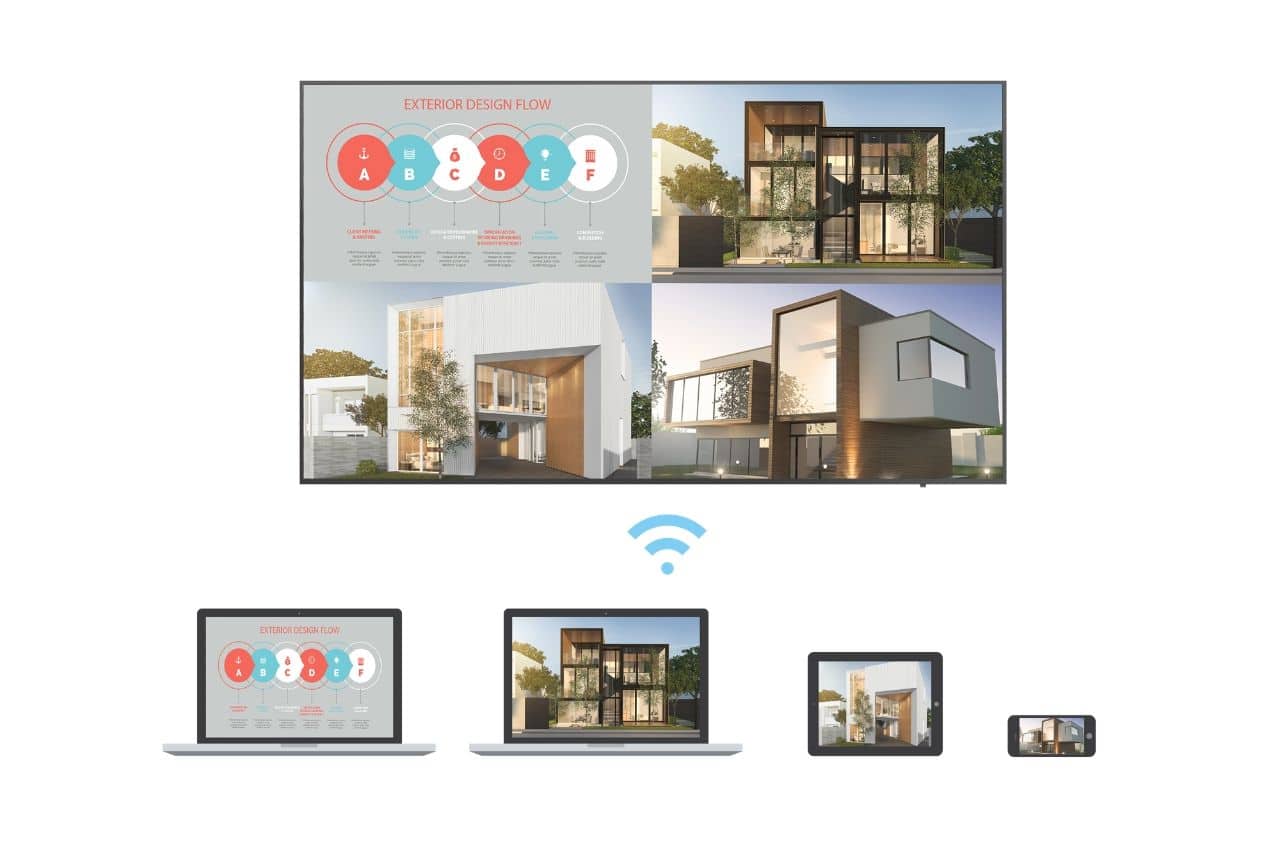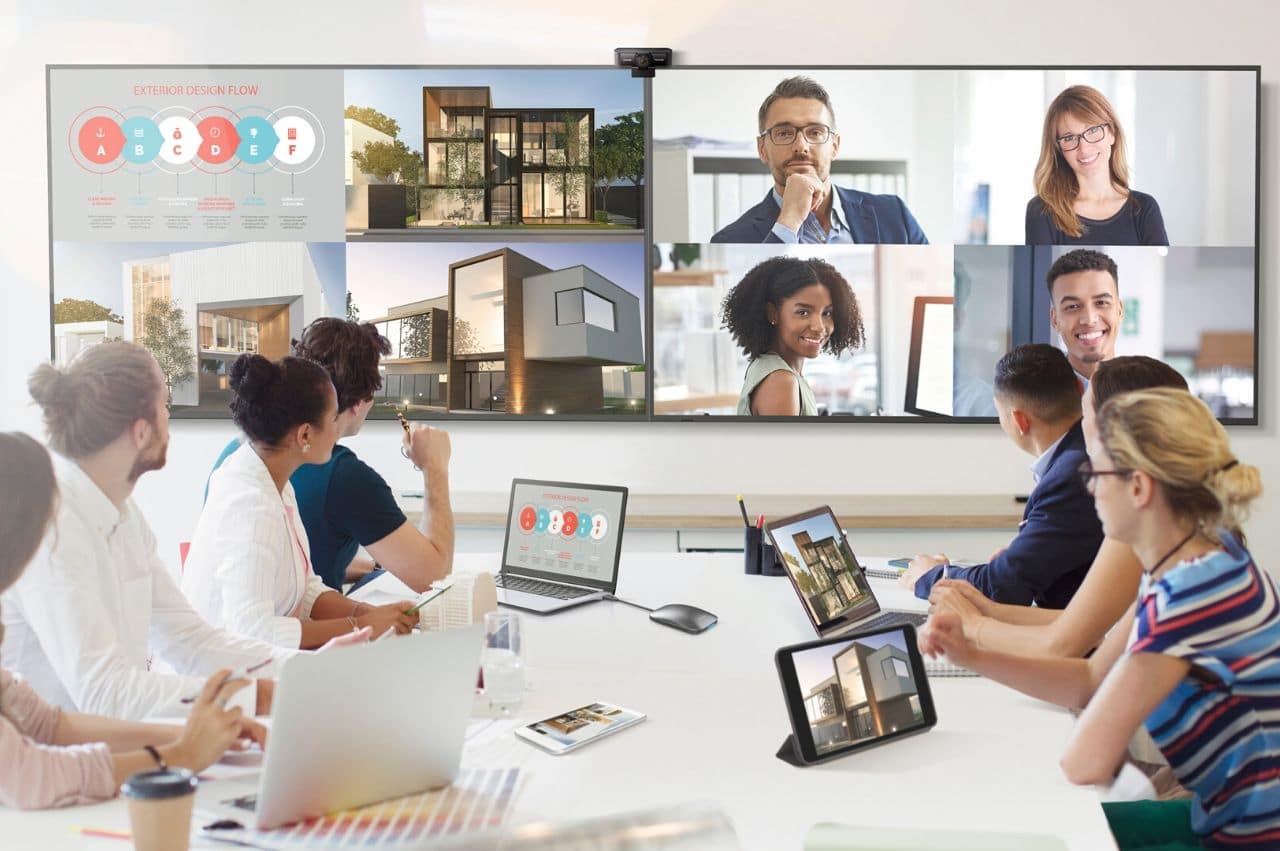A wireless presentation display (WPD) is a display with integrated connectivity used for presentations and collaboration. The systems are designed to work the same as more complex wireless presentation systems, but offering the same collaboration and connectivity in a fully integrated system. Uses include meeting rooms, training rooms, classrooms, commercial displays, and office communications.
Learn more about wireless presentation displays and their function below. Or see ViewSonic’s solution here.
Just setting up for a meeting and getting presenters connected can waste valuable time. As meetings are already a huge time commitment, it’s essential to minimize wasted time (and the frustration it causes).
Existing solutions include projectors, interactive whiteboards, and complex wireless presentation systems, but some situations call for a simpler – but still elegant – device in the form of a wireless presentation display.
What is a Wireless Presentation Display (WPD)?
A wireless presentation display is an all-in-one presentation system including simple wireless connectivity, screen sharing, and an integrated multimedia display. Their purpose is to make content sharing easier with no cables and no interruptions from switching sources.
A WPD should also include the ability to share multiple screens at once – even from multiple locations – allowing for easier collaboration during meetings and presentations. They should also support videoconferencing peripherals in the form of cameras and microphones.
How Is It Different from a Wireless Presentation System?
A wireless presentation system (WPS) is a hardware solution for integrating multiple other devices into a wireless system. Usually, it is a box that physically connects some combination of stand-alone displays, wireless routers, cameras, microphones, and other necessary peripherals.
Standard displays without built-in wireless connectivity also require external dongles to attach new devices, a problem that WPDs address by allowing known users to connect automatically through an application.

Why Use a Wireless Presentation Display?
Wireless presentation displays shine in situations where one or many devices are going to connect to the same shared display. The device makes it easy to connect wirelessly from anywhere in the room and switch displays without interrupting the presentation, so it’s great for teams that frequently meet and collaborate.
Given their wireless connectivity, WPDs also make it easier for IT to manage the devices. Especially handy in large organizations, an IT manager can change configurations and directly share content over the network instead of having to manually address every problem.
Wireless presentation displays also fill a specific need between projectors and interactive whiteboards, though all three are displays well suited to certain situations.
While they typically have a lower initial cost, projectors have a higher total cost of ownership (TCO) than flat-panel displays due to regular maintenance and a larger number of moving parts that could break (e.g. fans). Also, unless you’re using a fixed projector with wireless integration, there’s a good chance you’ll have to spend time calibrating the device each time you use it.
On the other hand, interactive whiteboards (IWBs) are a more advanced – and more expensive – option that takes advantage of a flat-panel display and add touchscreen functionality for digital whiteboarding. However, the additional functions may not be necessary or even interfere with the regular use of the display. Using a touch screen also requires close proximity, which can block many viewing angles for large teams’ collaborations.
Most important, however, is the single-device wireless solution that WPDs offer. As a simplified, integrated system wireless presentation displays allow multiple users to connect seamlessly, share content from their devices, and not have to fiddle with the shared cables so common to modern meeting rooms.
Common Uses for a Wireless Presentation Display
As one of several devices available, it’s important to know where a WPD is actually the best choice. The easy connectivity, screen sharing, and image quality combined with a reasonably priced, integrated system certainly benefit a number of environments.
- Meeting rooms, conference rooms, and huddle spaces are the most likely candidates for a wirelessly connected display. It’s an ideal solution for presentations and collaboration from individual devices, especially when multiple screens are shared at once. And since most meetings happen while everyone is in their seats, a large touchscreen display isn’t strictly necessary.
- Training rooms can also use the combined connectivity and screen sharing of wireless presentation displays, especially with 2-way screencasting. Even if the trainee can’t see the main display, the trainer can share their screen with everyone with the click of a button. A larger training venue – or even a school – could even cast to multiple large WPDs simultaneously.
- Small- and medium-sized classrooms are also good places for a front-of-classroom display like this. They work especially well where the lesson format is mostly lectures, especially in higher education, or as one of several classroom projector alternatives.
- Commercial display in retail outlets and public spaces was one of the original functions of large-format displays like WPDs. Going wireless has the additional benefit of reducing the need for data cables and other problematic infrastructure. Keep displays up to date with nothing more than a power source.
- Office communications is a more novel use for digital displays, but one that has a lot of merits. Having high-quality, dynamic displays around the office is a great way to improve internal communication and employee engagement. Learn more about improving communications with digital signage here.
When NOT to Use a Wireless Presentation Display
Wireless presentation displays are a great addition to presentations, except when there’s a better option.
- Very small collaborative spaces like two-person huddle rooms probably don’t need such a large shared display. A more reasonably sized monitor either on the table or mounted on the wall could do the job just fine. Bigger isn’t always better, so be sure to choose the right device for the space.
- Large spaces like lecture halls or auditoriums probably aren’t well suited to the fixed size of a flat-panel display. A projector with a high lumen count that can produce larger images might be a better choice for larger spaces and audiences.
- Interactive presentations like frequent brainstorming or lessons often require a more direct path towards annotating and manipulating objects on the screen. When it’s necessary to regularly interact with the displayed content, interactive whiteboards are a better choice.
Final Thoughts
The wireless presentation display (WPD) is a new class of collaborative display. It simplifies the setup and operation of a shared screen by integrating all the necessary hardware and software to provide a streamlined collaborative device. By occupying a space between a clunky, jury-rigged conference room TV and a more advanced interactive whiteboard, WPDs offer a solution to organizations looking to move away from projectors without breaking the bank on unnecessary features.
Learn more about the ViewSonic CDE7520 wireless presentation solution. Or get a run-down on effective meetings here.